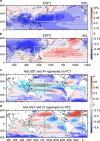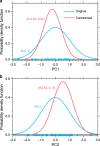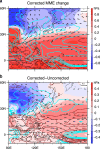Emergent constraints on future projections of the western North Pacific Subtropical High
- PMID: 32499522
- PMCID: PMC7272422
- DOI: 10.1038/s41467-020-16631-9
Emergent constraints on future projections of the western North Pacific Subtropical High
Abstract
The western North Pacific Subtropical High (WNPSH) is a key circulation system controlling the summer monsoon and typhoon activities over the western Pacific, but future projections of its changes remain hugely uncertain. Here we find two leading modes that account for nearly 80% intermodel spread in its future projection under a high emission scenario. They are linked to a cold-tongue-like bias in the central-eastern tropical Pacific and a warm bias beneath the marine stratocumulus, respectively. Observational constraints using sea surface temperature patterns reduce the uncertainties by 45% and indicate a robust intensification of the WNPSH due to suppressed warming in the western Pacific and enhanced land-sea thermal contrast, leading to 28% more rainfall projected in East China and 36% less rainfall in Southeast Asia than suggested by the multi-model mean. The intensification of the WNPSH implies more future monsoon rainfall and heatwaves but less typhoon landfalls over East Asia.
Conflict of interest statement
The authors declare no competing interests.
Figures







References
-
- Wang B, Wu R, Lau KM. Interannual variability of the Asian summer monsoon: contrasts between the Indian and the western North Pacific-East Asian Monsoon. J. Clim. 2001;14:4073–4090.
-
- Wu B, Zhou T, Li T. Seasonally evolving dominant interannual variability modes of East Asian climate. J. Clim. 2009;22:2992–3005.
-
- Wang B, Yang J, Zhou T, Wang B. Interdecadal changes in the major modes of Asian–Australian monsoon variability: strengthening relationship with ENSO since the late 1970s. J. Clim. 2008;21:1771–1789.
Publication types
LinkOut - more resources
Full Text Sources

